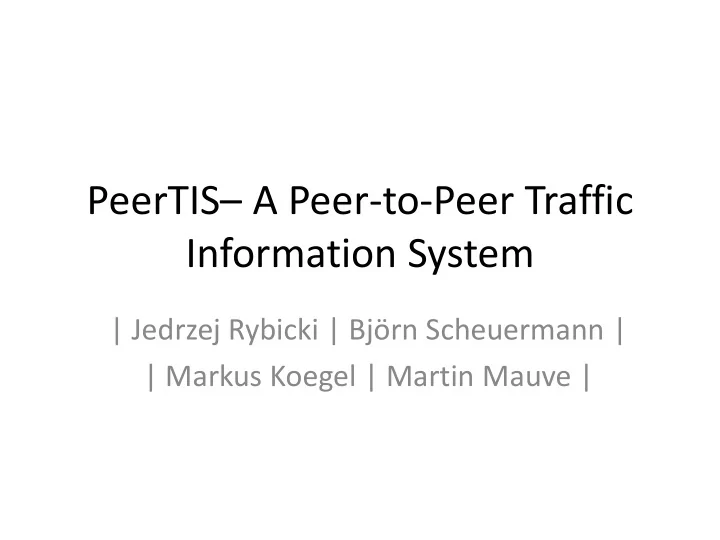

PeerTIS – A Peer-to-Peer Traffic Information System | Jedrzej Rybicki | Björn Scheuermann | | Markus Koegel | Martin Mauve |
VANETs • Limited network capacity ? Limited scalability, connectivity • No immediate market penetration • Benefits: – User-driven, Decentralized
Infrastructure-based Cellular Communication (i.e. UMTS) Assumptions: – Each car connected to cellular Internet (IP-based communication channel between cars)
TIS • Distributed database of traffic measurements
Peer-to-Peer Internet Overlay Over Infrastructure-based networks • Robust and efficient search and data retrieval • Redundant storage • Scalability • Decentralized
The TIS Application • Street segment IDs as keys measurements on the segment as values • Use any DHT and apply it to TIS ?
Cellular Internet Access limitations: • Bandwidth and Latency limitations • Mobile stations limited storage and processing power
Reduce Communication Burden • Non-random access operations / Exhibits locality property
Content Addressable Network (CAN) • Key-values mapped to points in d-dimensional space, key space • One zone/peer • Peer joins – Split • Peer leaves – Merge
CAN continued… • Communication Overlay formed by connecting neighbor peers in the key space. • Routing Table • Greedily forwarding of requests
Naïve Approach (CAN) • Identify relevant road segments • Determine the position of the segments in the key space • Locate responsible peers
A P2P Overlay for TIS (PeerTIS) Improving the Lookup Performance • Keep the relationship between the road segments • No hashing – use geographical coordinates • Looked-up road segments are contiguous – peers in the overlay are closer • More efficient lookups – Multi-hop lookups
Load Distribution • No uniform distribution of segment IDs over the key space (maintain locality) • Homogeneous zone sizes in original CAN • Higher load for peers responsible for dense zones • Solution: Smaller zone sizes in dense areas • Achieved: by considering physical location of cars – not random
Exploiting Temporal Correlations • Subsequent requests/updates by the same peer to the same geographical area (even the same road segment) • Each peer maintain cache of contact data of peers on the planned route – can be directly contacted for update-requests and and update-uploads (own measurement) •
Feasibility VISSIM microscopic traffic simulator to generate car movements, 500km roads, up to 10,000 vehicles • Bandwidth and Latency – UTMS bound 384kB/s upload – GSM/GPRS 42kB/s
• Performance – Number of hops in the overlay – 90% of lookups require 2 hops
Recommend
More recommend